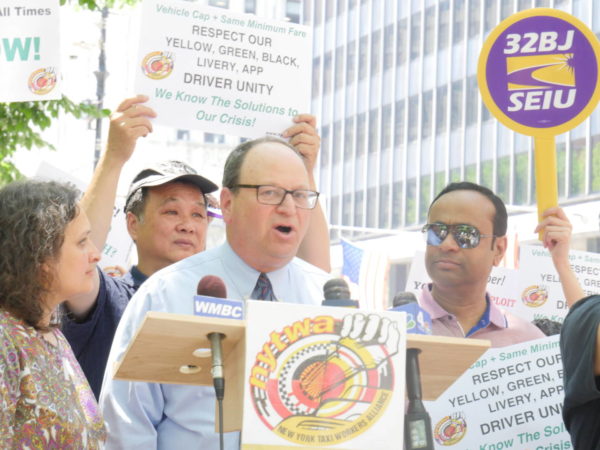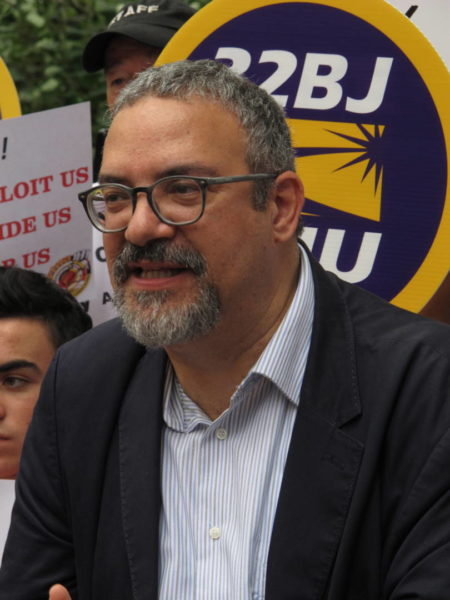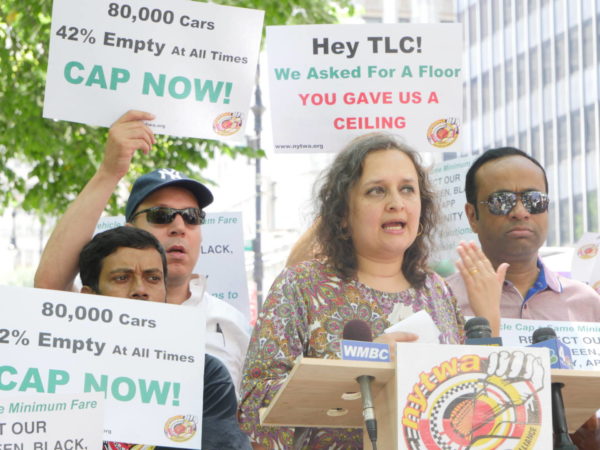NEW YORK, N.Y.—This week, the City Council quickly rejected an offer by Uber and Lyft that they would set up a $100 million fund to help yellow-cab owner-drivers overloaded with debt—if the Council would abandon bills intended to regulate them.

“We don’t negotiate in public, but we can say that we are confident the bills that will be voted on will help drivers, reduce congestion, and bring fairness to the industry,” Jennifer Fermino, a spokesperson for Council Speaker Corey Johnson, said in a statement Aug. 1. She added that “Lyft and other high-volume for-hire-vehicle companies” were welcome to establish such a fund on their own.
The bills the two app-based cab companies wanted dropped would create a new class of license for “high-volume for-hire-vehicle companies,” instead of them using individual drivers’ black-car licenses, and stop the city Taxi and Limousine Commission from issuing new for-hire-vehicle licenses, except for wheelchair-accessible cabs, for a year. During that year, a commission would study whether to impose permanent limits on the number of for-hire vehicles.

“I think the City Council is acting responsibly by saying, let’s take a pause…let’s limit the number very close to what we have now,” Hector Figueroa, president of SEIU 32BJ told LaborPress. “Let’s not issue any new vehicles in the streets. We have, like 80- to 100,000 vehicles; they’re meeting the needs of New Yorkers. And then, see what is the appropriate minimum fare, where it makes sense, and a minimum income that drivers can be guaranteed to have. Obviously, they can have more, but there is a floor that protects livelihoods.”
Uber argues that capping the number of for-hire vehicles “will not reduce street congestion” and would make its cabs harder to find outside of Manhattan. “Without being able to add cars to service the entire city, much of the progress we’ve made in bringing reliable transportation access to the outer boroughs could disappear,” it says. “More riders looking for rides with fewer drivers able to fulfill those requests is a recipe for higher prices and increased wait times.”
I think the City Council is acting responsibly by saying, let’s take a pause…let’s limit the number very close to what we have now — Hector Figueroa, president of SEIU 32BJ
Adding massive numbers of cabs—there are now actually, as many as 130,000 for-hire vehicles in the city, more than double the amount five years ago—is central to the app-based business model, however. That expansion has obliterated the traditional restrictions on the number of cabs. The city has limited the number of yellow cabs, which can pick up street hails, for more than 80 years, in order to ensure that there weren’t too many drivers competing for the same fares. But as app-based companies make money by collecting a percentage of the fare, without having to invest in cars or medallions, they can expand without risking losing money.
“Uber’s has the capacity to [flood the streets] because they’re a big corporation,” Figueroa said. “They can operate with losses in a market because they can make that profit in Germany, or make that profit in other parts of the U.S. And then come back and restore the price to reflect the true cost. But in the process, a lot of people are bankrupted, lives destroyed and operators of medallions are gone — and then Uber has the market for themselves. This is a predatory pricing strategy — anybody who knows about economics knows about it.”
The increased competition has decimated drivers’ incomes across the board, but yellow-cab owner-drivers have been the hardest hit. The value of yellow-cab medallions, which inflated to as high as $1.3 million in 2014, has plummeted to below $200,000. That has left drivers who took out loans to buy them when prices were high owing hundreds of thousands more than the medallions are now worth. Two of the six drivers who have committed suicide since last November were underwater owner-drivers.

But the fund offer, Bhairavi Desai of the New York Taxi Workers Alliance said in a message to LaborPress, “was a hush fund for struggling workers so the companies could evade regulation. Owner-drivers never asked for it. All drivers asked for sound regulation. The Council was right to reject it and stay firm on regulation. It’s the same classic story of corporations desperate to avoid paying workers more throwing newfound money on the table.”
“I think that Uber is very cynical about [the offer].” Figueroa said. “It’s like, they create a condition in which medallion drivers are going into bankruptcy and are emotionally and physically and economically desperate, working long hours, unable to pay the debt. So, I think that the offer is just a way to try to win over the Council and avoid an historic breakthrough of legislation that, quite frankly, is long overdue. We should have passed it in 2015, when we needed the vote, and now, we have six driver who are no longer with us. The Council has to act now and ignore any efforts of bribery, quite frankly, by Uber.”
Teamsters Joint Council 16 spokesperson Alex Moore expressed similar sentiments on Twitter: “Uber’s $100 million ‘hardship fund’ for taxi drivers reminds me of the companies who all of a sudden have money for big raises when workers are about to form a union,” he wrote.
Senior Editor Joe Maniscalco contributed additional reporting to this story.



